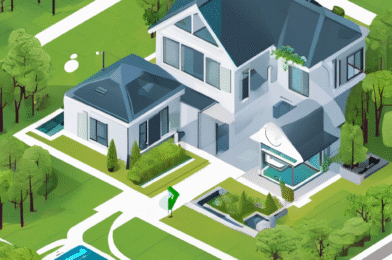Are Smart Homes Actually Good for the Planet? We Investigate.
The concept of smart homes has been increasingly popular over the last decade. With the rise of eco-consciousness, many believe smart homes could be the future of sustainable living. But are they actually good for the planet?
As the name suggests, smart homes employ innovative technology to create more efficient living spaces. From smart thermostats to voice-activated lighting, these gadgets promise convenience and energy savings. Many features rely on motion sensors, so lights and appliances are engaged only when needed.
But the energy-saving potential is not the only appeal. Smart speakers, like Amazon’s Echo, boast the ability to control multiple devices from one central hub. This streamlined setup is a draw for many consumers who appreciate the convenience of a simplified tech ecosystem.
There’s no denying the initial appeal of these tech-savvy homes, but it’s also necessary to consider their environmental impact. The production of these gadgets often relies on rare earth metals and plastics, raising concerns about resource extraction and electronic waste.
So, are smart homes sustainable, or do they create newfound environmental challenges? Let’s delve deeper into the debate.
One of the key advantages of smart home technology is its potential to reduce energy consumption. Smart thermostats, for example, can learn a household’s preferences, automatically adjusting temperatures to an energy-efficient setting.
Smart lighting systems are another energy-saving feature. LEDs, which consume up to 80% less energy than traditional bulbs, can be programmed to switch off when not in use. And with voice-activated controls, users can easily adjust lighting levels, ensuring lights are never left on unnecessarily.
The benefits don’t stop at energy savings. Smart appliances can help monitor and manage water usage too. Smart meters provide real-time data on water consumption, while some apps even offer leak detection and automatic shut-off valves.
For eco-conscious homeowners, there’s a lot to love about the potential of smart homes. But with any new technology, there are also drawbacks to consider.
The biggest concern is the high rate of electronic waste generated by these smart gadgets. A 2023 study found that the average smart home device has a lifespan of merely two to three years. Considering the rapid pace of technological advancement, it’s easy to see how quickly these devices can become obsolete.
The production and disposal of these products have significant environmental implications. The mining of rare earth metals, essential for many smart devices, is a contentious issue. This process often occurs in countries with lax environmental regulations, leading to severe ecological and social impacts.
Furthermore, the manufacturing process, especially for plastics, contributes to air pollution and greenhouse gas emissions. Considering the short lifespan of these gadgets, the cumulative effect on the environment is considerable.
Amidst the pros and cons, one thing is clear: the concept of smart homes is here to stay. As the technology evolves, it’s integration with renewable energy sources could be a game-changer.
Some innovative designs are incorporating solar panels and wind turbines into home architecture, harnessing the potential of renewable energy. Smart homes could become micro-grids, efficiently managing their power consumption and even contributing to the main grid during periods of high demand.
Moreover, improved connectivity and AI enhancements will likely enable more efficient energy management. AI algorithms can analyze patterns to optimize energy use, going beyond current motion sensor capabilities.
As we investigate the impact of smart homes on the planet, it’s evident that they offer both promises and perils. While they have the potential to reduce energy consumption and engage users in sustainable practices, there are serious concerns about the environmental toll of their production and short lifespans.
Perhaps the key take-away is the importance of balancing technological advancements with eco-conscious design. As consumers, we must ask not only what gadgets can do for us but also consider their long-term environmental implications.
For now, it’s clear that the journey towards a sustainable future is an ongoing one, and the role of smart homes in this narrative is yet to be fully determined.
